Parasola auricoma (Pat.) Redhead, Vilgalys & Hopple - Goldenhaired Inkcap
Phylum: Basidiomycota - Class: Agaricomycetes - Order: Agaricales - Family: Psathyrellaceae
Distribution - Taxonomic History - Etymology - Identification - Culinary Notes - Reference Sources
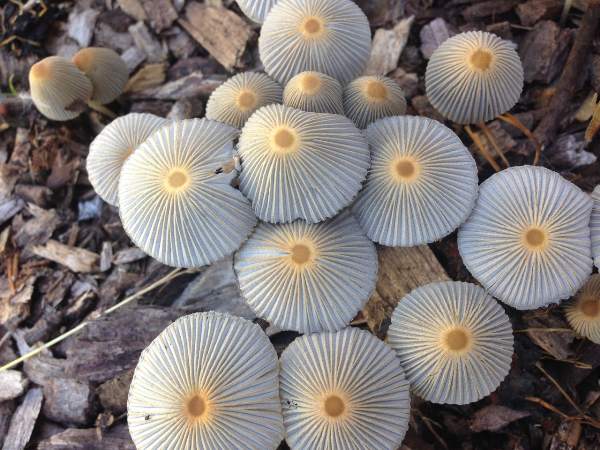
Parasola auricoma (formerly called Coprinus auricoma) is a short-lived delicate member of the inkcap group of fungi. It, together with two or three lookalikes that are difficult to separate without examining them using a microscope) is easily confused with the Pleated Inkcap (also referred to as the Little Japanese Parasol) Parasola plicatilis.
Parasola auricoma, which was recently given the common name Goldenhaired Inkcap in the British Mycological Society'e list of English names of fungi, is an inkcap of woodland habitats, where it grows among twigs and leaf litter. In parks and gardens this little mushroom is common in flowerbeds covered in woodchip mulch.
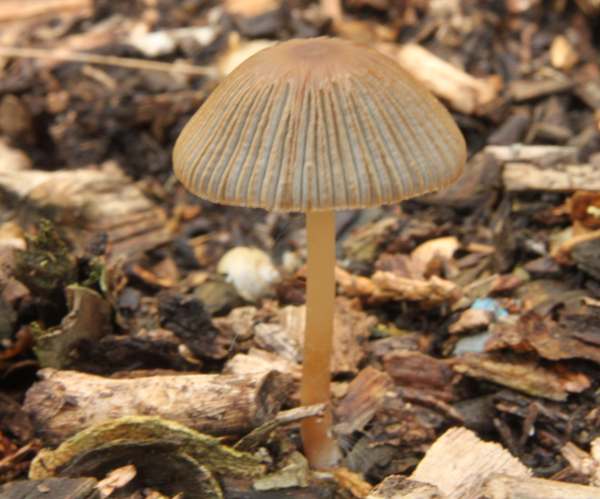
The picture shown above is of a mature specimen, while those illustrated below include a mixture of immature and mature fruitbodies from the same location in Terrasse-Vaudreuil, Quebec, Canada, where they errupted after woodchip mulch had been covered by dirty floodwater. The colour change between somewhat browner (but very variable) young and greyer older specimens is one of the factors that makes identification of Parasola mushrooms from macroscopic characters alone very difficult.
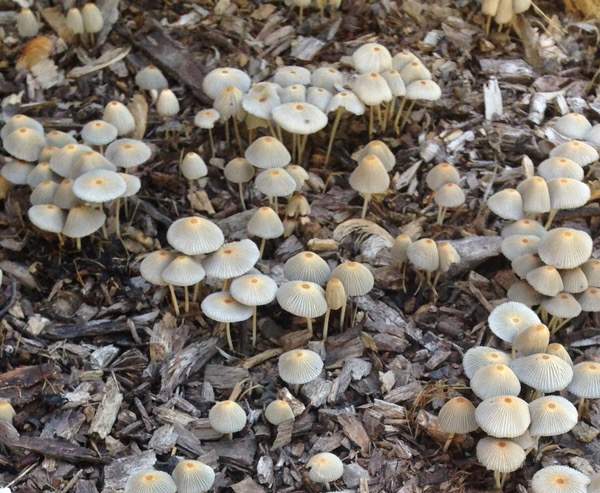
All of the Parasola mushrooms are short-lived fruitbodies, looking at their very best for two or three hours at the most, and rather less than that in dry hot weather. So, if you find a nice photogenic group of these neat little fungi at a time when you haven't got a camera with you, it's no good planning on returning the next day, because for certain the caps will have either collapsed and the stems folded over or, most lilely, the whole group will have disappeared without trace. (Of course, there is always the possibilty that some more fruitbodies will have erupted from the same fungal mycellium!)
Distribution
Uncommon (except in gardens on woodchip mulch) across Britain and Ireland, Parasola auricoma is also found throughout mainland Europe; it has also been recorded in Japan and in many parts of North America.
Taxonomic history
This little inkcap was described in 1886 by Narcisse Theophile Patouillard (1854 - 1926), who called it Coprinus auricomus, a scientific name by which it was known until 2001 when the DNA-based research findings of Redhead, Vilgalys & Hopple were published. Its scientific name was then changed to Parasola auricoma.
Synonyms of Parasola auricoma include Coprinus auricomus Pat., and Coprinus hansenii J. E. Lange.
Etymology
The specific epithet auricoma may come from aur- meaning golden and com or coma meaning hair - references to the golden colour of young caps and the red-brown hair-like setae visible (you may need to use a hand lens) on the cap surface. Any other suggestions would be most welcome!
Identification guide
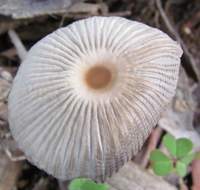 |
CapThe cap of Parasola auricoma has a diameter of 1.5 to 2.2cm and is initially egg-shaped and almost smooth, later becoming convex, deeply ribbed and finally opening out to become almost flat. A distinctive tawny central 'eye', much the same colour as the very young fruitbody, now contrasts with the rest of the mature greyish cap. There are long, narrow hair-like setae (sometimes quite sparse) among the cap cells. These features can be seen with a x15 hand lens or under a low-powered microscope. |
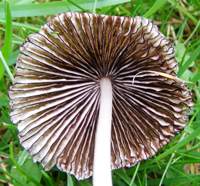 |
GillsThe white gills are moderately spaced, adnate or adnexed to (or occasionally just free of but not remote from) the stem, turning grey-brown and then black. Unlike most ink caps, this delicate little fungus has a cap that flattens and then shrivels rather than its gills deliquescing (turning to a black inky liquid). Stem4 to 7.5cm long, but no more than 2 to 4mm in diameter and very fragile, the stems are silky or faintly fibrillose, white or dingy cream, and cylindrical, often with a slightly swollen base that is covered in fine white down. |
SporesBroadly ellipsoidal - ovoid in face view, 10-14 x 6-8μm. Spore printBlack. |
|
Odour/taste |
Not distinctive. |
Habitat & Ecological role |
Saprobic on twigs and leaf litter in broadleaf woodland and, increasingly, on woodchip mulch in parks and gardens. |
Season |
May to November in Britain and Ireland. |
Similar species |
Parasola plicatilis and Parasola leiocephala are much paler when immature and do not have hair-like setae on the cap; they are grassland and woodland-edge inkcaps respectively and are not usually found on fine woody debris. |
Culinary Notes
This inkcap is generally regarded as inedible, and its small size and thin flesh mean that there is little temptation to try eating this insubstantial mushroom.
Reference Sources
Fascinated by Fungi, 2nd Edition, Pat O'Reilly 2016, reprinted by Coch-y-bonddu Books in 2022.
Patouillard NT. (1886). Tabulae Analyticae Fungorum (published in French) 1 (5). pp. 181–232
Redhead S, Vilgalys R, Moncalvo J-M, Johnson J, Hopple JS Jr. (2001). "Coprinus Pers. and the disposition of Coprinus species sensu lato". Taxon 50: 203–75.
Orton, P.D. & Watling, R. 1979. British Fungus Flora: Agarics and Boleti. Vol 2. Coprinaceae: Coprinus. Royal Botanic Garden: Edinburgh, Scotland.
Dictionary of the Fungi; Paul M. Kirk, Paul F. Cannon, David W. Minter and J. A. Stalpers; CABI, 2008
Taxonomic history and synonym information on these pages is drawn from many sources but in particular from the British Mycological Society's GB Checklist of Fungi.
Acknowledgements
This page includes pictures kindly contributed by Audrey Drake.
Fascinated by Fungi. Back by popular demand, Pat O'Reilly's best-selling 450-page hardback book is available now. The latest second edition was republished with a sparkling new cover design in September 2022 by Coch-y-Bonddu Books. Full details and copies are available from the publisher's online bookshop...

